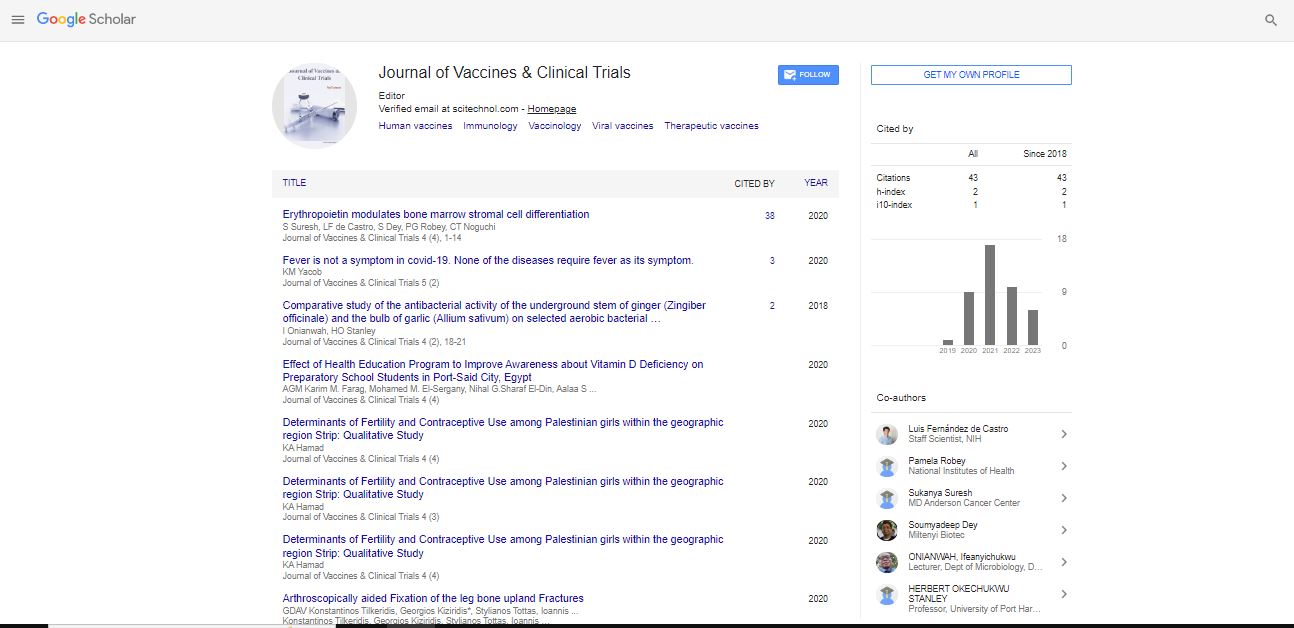Perspective, Jou Of Vac Cli Tr Vol: 7 Issue: 1
The Science of Vaccinology: Understanding the Development and Importance of Vaccines
Dochez Lambert H*
1Department of Vaccinology, University of Geneva, Rue Michel Servet, 1211 Geneva 4, Switzerland
*Corresponding Author: Dochez Lambert H
Department of Vaccinology,
University of Geneva, Rue Michel Servet, 1211 Geneva 4, Switzerland
E-mail: hdochey7878@gmail.com
Received date: 24 February, 2023, Manuscript No. JVCT-23-94633;
Editor assigned date: 28 February, 2023, PreQC No. JVCT-23-94633(PQ);
Reviewed date: 13 March, 2023, QCNo JVCT-23-94633;
Revised date: 21 March, 2023, Manuscript No. JVCT-23-94633 (R);
Published date: 30 March, 2023, DOI: 10.4172/JVCT.1000667.
Citation: Lambert HD (2023) The Science of Vaccinology: Understanding the Development and Importance of Vaccines. Jou of Vac Cli Tr 7:1.
Description
Vaccines are one of the most effective tools in preventing infectious diseases. They work by stimulating the immune system to produce a protective response against specific pathogens, thereby reducing the risk of infection and its associated complications. This manuscript provides an overview of the science of vaccinology, including the history, development, and importance of vaccines. We also discuss the challenges associated with vaccine development, the different types of vaccines, and the role of vaccines in public health.
Infectious diseases have been a constant threat to human health throughout history. Despite significant advances in medicine and public health, infectious diseases remain a major cause of morbidity and mortality worldwide. Vaccines have been an important tool in reducing the burden of infectious diseases, with some diseases almost eradicated through vaccination programs. The science of vaccinology encompasses the development, production, and use of vaccines to prevent and control infectious diseases.
Background of vaccines
The history of vaccines dates back to the 18th century when Edward Jenner discovered that cowpox infection could protect against smallpox. This led to the development of the first vaccine, which was made from cowpox virus and used to protect against smallpox. Since then, vaccines have been developed for a wide range of infectious diseases, including polio, measles, mumps, rubella, hepatitis B, and Human Papillomavirus (HPV), among others.
The development of a vaccine involves a complex process that can take several years. The first step in vaccine development is the identification of a suitable antigen that can stimulate the immune system to produce a protective response. This can be a protein, a carbohydrate, or a nucleic acid from the pathogen. Once the antigen is identified, it is purified and formulated into a vaccine.
Vaccine production can be done using different methods, including live-attenuated, inactivated, subunit, and recombinant DNA technologies. Live-attenuated vaccines contain a weakened form of the pathogen, while inactivated vaccines are made from killed pathogens. Subunit vaccines contain only the parts of the pathogen that can stimulate an immune response, while recombinant DNA vaccines use genetic engineering to produce a protein that can stimulate the immune system.
Challenges in vaccine development
Vaccine development can face several challenges, including the need for animal models for testing, the high cost of development and production, and the potential for adverse reactions. The development of a vaccine can also be complicated by the variability of the pathogen and the need to ensure the safety and efficacy of the vaccine.
Types of vaccines
There are several types of vaccines, each with its advantages and disadvantages. Live-attenuated vaccines, such as the Measles, Mumps, and Rubella (MMR) vaccine, provide long-lasting immunity but can be dangerous for people with weakened immune systems. Inactivated vaccines, such as the polio vaccine, are safer but may require booster shots to maintain immunity. Subunit vaccines, such as the HPV vaccine, are safe and effective but may require multiple doses for full protection. Recombinant DNA vaccines, such as the hepatitis B vaccine, are effective but expensive to produce.
Importance of vaccines
Vaccines are a critical tool in preventing and controlling infectious diseases. They have been responsible for the eradication of smallpox, the near-eradication of polio, and the significant reduction of other infectious diseases worldwide. Vaccines also provide protection against outbreaks of infectious diseases, reducing the risk of epidemics and pandemics.
 Spanish
Spanish  Chinese
Chinese  Russian
Russian  German
German  French
French  Japanese
Japanese  Portuguese
Portuguese  Hindi
Hindi 